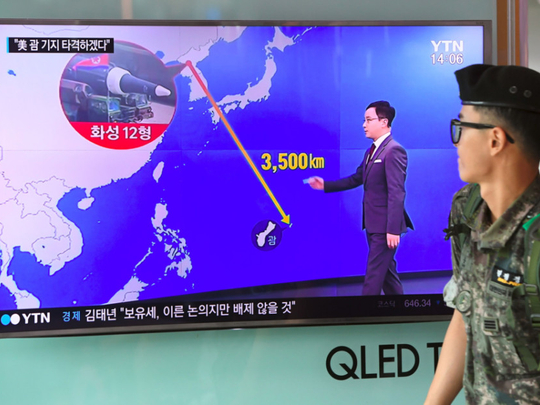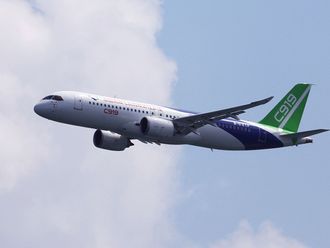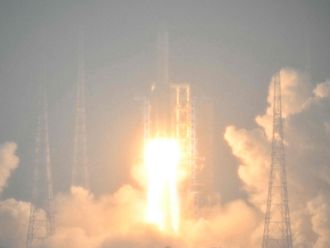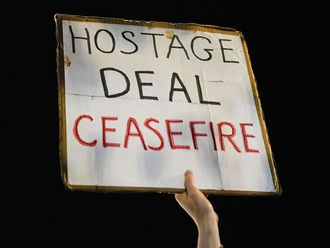
BRIDGEWATER, N.J: President Donald Trump threatened on Tuesday to unleash “fire and fury” against North Korea if it endangered the United States, as tensions with the isolated and impoverished nuclear-armed state escalated into perhaps the most serious foreign policy challenge yet of his administration.
In chilling language that evoked the horror of a nuclear exchange, Trump sought to deter North Korea from any actions that would put Americans at risk. But it was not clear what specifically would cross his line. Administration officials have said that a pre-emptive military strike, while a last resort, is among the options they have made available to the president.
“North Korea best not make any more threats to the United States. They will be met with fire and fury like the world has never seen,” Trump told reporters at his golf club in Bedminster, where he is spending much of the month on a working vacation.
Referring to North Korea’s volatile leader, Kim Jong Un, Trump said, “He has been very threatening beyond a normal state, and as I said, they will be met with fire and fury, and frankly power the likes of which this world has never seen before.”
Undaunted, North Korea warned several hours later that it was considering a strike that would create “an enveloping fire” around Guam, the western Pacific island where the United States operates a key Air Force base. In recent months, US strategic bombers from Guam’s Andersen Air Force Base have flown over the Korean Peninsula in a show of force.
“Will only the US have option called ‘preventive war’ as is claimed by it?” the Strategic Force of the North’s Korean People’s Army, or KPA, said in a statement. “It is a daydream for the US to think that its mainland is an invulnerable Heavenly kingdom.”
“The US should clearly face up to the fact that the ballistic rockets of the Strategic Force of the KPA are now on constant standby, facing the Pacific Ocean and pay deep attention to their azimuth angle for launch,” the statement said.
Trump’s stark comments went well beyond the firm but measured language typically preferred by US presidents in confronting North Korea, and indeed seemed almost to echo the bellicose words used by Kim. Whether that message was mainly a bluff or an authentic expression of intent, it instantly scrambled the diplomatic equation in one of the world’s most perilous regions.
Supporters suggested Trump was trying to get Kim’s attention in a way that the North Korean would understand, while critics expressed concern that the president could stumble into a war with devastating consequences.
“This is a more dangerous moment than faced by Trump’s predecessors,” said Mark Dubowitz, chief executive of the Foundation for Defense of Democracies, a nonprofit group in Washington. “The normal nuanced diplomatic rhetoric coming out of Washington hasn’t worked in persuading the Kim regime of American resolve. This language underscores that the most powerful country in the world has its own escalatory and retaliatory options.”
But Sen. Dianne Feinstein, D-Calif., said it would be counterproductive. “President Trump is not helping the situation with his bombastic comments,” she said in a statement.
Sen. John McCain, R-Ariz., chairman of the Armed Services Committee, also took exception. “All it’s going to do is bring us closer to some kind of serious confrontation,” he told KTAR radio.
In Guam, Gov. Eddie Baza Calvo played down the North’s threat to the island in a video address Wednesday. He said that his administration had been in touch with the White House and US military commanders and that there was “no change in the threat level resulting from North Korea events.”
North Korea has accelerated its progress toward a working nuclear-tipped missile force since Trump, who has vowed not to let that happen, took office. Last month, the North successfully tested for the first time an intercontinental ballistic missile that could reach the continental United States.
The Washington Post reported Tuesday that US intelligence agencies had concluded that North Korea had miniaturized a warhead that could fit on top of one of its missiles. The Japanese government also said in an annual threat assessment Tuesday that “it is possible that North Korea has already achieved the miniaturization of nuclear weapons and has acquired nuclear warheads.”
But experts said the main problem for North Korea is not miniaturization; the bombs are already judged small enough to fit on a ballistic missile, as a famous picture of Kim with a warhead seemed to make clear. The real test is whether a warhead can survive the intense heat of re-entry as it plunges through the atmosphere from space, a hurdle North Korea is not believed to have overcome.
While Trump’s statement was among the most militant a president has made about North Korea, it may have been aimed as much at Beijing as Pyongyang. By discussing military options, the administration may be trying to convince China and its president, Xi Jinping, that the status quo is dangerous because it risks war.
“It may be a message to Xi Jinping that you have to be doing more than just sanctions at the UN,” said Joseph Nye, a Harvard University scholar who once ran the US government’s National Intelligence Council. “It may be a very rational, thought-out message,” rather than an emotional outburst, he added.
While Secretary of State Rex W. Tillerson has kept the door open for talks with North Korea during his travels in the region, other administration officials have said Trump is being presented with options for war.
“The president has been very clear about it,” Lt. Gen. H.R. McMaster, the national security adviser, said in an interview aired on MSNBC last weekend. “He said he’s not going to tolerate North Korea being able to threaten the United States.”
McMaster added, however, that the administration would first explore “what can we do to make sure we exhaust our possibilities, and exhaust our other opportunities to accomplish this very clear objective of denuclearisation of the peninsula short of war.”
In South Korea, some conservative politicians and analysts have called for the reintroduction of US tactical nuclear weapons to establish a “balance of terror” against the North. The United States withdrew nuclear weapons from the South in the early 1990s, but it occasionally sends nuclear-capable bombers and submarines in exercises.
But President Moon Jae-in on Monday warned against military action. “Above all, President Moon emphasized that South Korea can never accept a war erupting again on the Korean Peninsula,” his office said in a statement describing a 56-minute phone call with Trump. “He stressed that the North Korean nuclear issue must be resolved in a peaceful, diplomatic manner through a close coordination between South Korea and the United States.”












